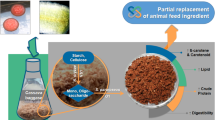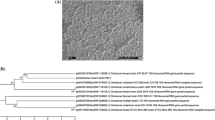Abstract
Agricultural products exhibit a “buffering nature” during autoclaving and fermentation processes: i.e., the final pH of agricultural product medium after Monascus fermentation maintains a certain value. The protein content of agricultural products strongly affects the buffering capacity and an extremely low final pH, below 3, can be achieved by the selection of agricultural products with low protein content, such as rice meal and cornmeal. This low pH can be used to inhibit citrinin biosynthesis during Monascus fermentation. Thus, optimal selection of agricultural products with low protein content may provide a novel strategy to inhibit citrinin production in submerged culture of Monascus anka at a low initial pH for the production of Monascus pigments. pH values ranging from 2.6 to 3 can be maintained in Monascus fermentation using cornmeal/wheat starch (30:30 g/L) as substrate at initial pH 2.5, where the concentration of intracellular pigments reaches 45 AU at 470 nm while citrinin is undetectable by TLC analysis.
Similar content being viewed by others
References
Juzlova, P., L. Martinkova, and V. Kren (1996) Secondary metabolites of the fungus Monascus: Review. J. Ind. Microbiol. 6: 163–170.
Feng, Y., Y. Shao, and F. Chen (2012) Monascus pigments. Appl. Microbiol. Biotechnol. 96: 1421–1440.
Blanc, P. J., J. P. Laussac, J. L. Bars, P. L. Bars, M. O. Loret, A. Pareilleux, D. Prome, J. C. Prome, A. L. Santerre, and G. Goma (1995) Characterization of monascidin A from Monascus as citrinin. Intern. J. Food Microbiol. 27: 201–213.
Liao, C.-D., Y.-C. Chen, H.-Y. Lin, L.-C. Chiueh, and D. Y.-C. Shih (2014) Incidence of citrinin in red yeast rice and various commercial Monascus products in Taiwan from 2009 to 2012. Food Control. 38: 178–183.
Tsukahara, M., N. Shinzato, Y. Tamaki, T. Namihira, and T. Matsui (2009) Red yeast rice fermentation by selected Monascus sp. with deep-red color, lovastatin production but no citrinin, and effect of temperature-shift cultivation on lovastatin production. Appl. Biochem. Biotechnol. 158: 476–482.
Xu M.-J., Z.-L. Yang, Z.-Z. Liang, and S.-L. Zhou (2009) Construction of a Monascus purpureus mutant showing lower citrinin and higher pigment production by replacement of ctnA with pks1 without using vector and resistance gene. J. Agric. Food Chem. 57: 9764–9768.
Xie, N., Q. Liu, and F. Chen (2013) Deletion of pigR gene in Monascus ruber leads to loss of pigment production. Biotechnol. Lett. 35: 1425–1432.
Hajjaj, H., P. J. Blanc, E. Groussac, G. Goma, J. L. Uribelarrea, and P. Loubiere (1999) Improvement of red pigment/citrinin production ratio as a function of environmental conditions by Monascus rubber. Biotechnol. Bioeng. 64: 497–501.
Pereira, D. G., A. Tonso, and B. V. Kilikian (2008) Effect of dissolved oxygen concentration on red pigments and citrinin production by Monascus purpureus ATCC 36928. Braz. J. Chem. Eng. 25: 247–253.
Lee, C.-L., H.-K. Hung, J.-J. Wang, and T.-M. Pan (2007) Improving the ratio of Monacolin K to citrinin production of Monascus purpureus NTU 568 under Dioscorea medium through the mediation of pH value and ethanol addition. J. Agric. Food. Chem. 55: 6493–6502.
Orozco, S. F. B. and B. V. Kilikian (2008) Effect of pH on citrinin and red pigments production by Monascus purpureus CCT3 802. World J. Microbiol. Biotechnol. 24: 263–268.
Carels, M. and D. Hepherd (1977) The effect of different nitrogen sources on pigment production and sporulation of Monascus species in submerged shaken culture. Can. J. Microbiol. 23: 1360–1372.
Chen, M.-H. and M. R. Johns (1993) Effect of pH and nitrogen source on pigment production by Monascus purpureus. Appl. Microbiol. Biotechnol. 40: 132–138.
Kang, B., X. Zhang, Z. Wu, H. Qi, and Z. Wang (2013) Effect of pH and nonionic surfactant on profile of intracellular and extracellular Monascus pigments. Proc. Biochem. 48: 759–767.
Kang, B., X. Zhang, Z. Wu, H. Qi, Z. Wang, and S. Park (2014) Production of citrinin-free Monascus pigments by submerged culture at low pH. Enz. Microb. Technol. 55: 50–57.
Ma, J., Y. Li, Q. Ye, J. Li, Y. Hua, D. Ju, D. Zhang, R. Cooper, and M. Chang (2000) Constituents of red yeast rice, a traditional Chinese food and medicine. J. Agric. Food Chem. 48: 5220-5225.
Velmurugan, P., H. Hur, V. Balachandar, S. Kamala-Kannan, J.-K. Lee, S.-M. Lee, J.-C. Cha, P. J. She, and B.-T. Oh (2011) Monascus pigment production by solid-state fermentation with corn cob substrate. J. Biosci. Bioeng. 112: 590–594.
Dominguez-Espinosa, R. M. and C. Webb (2003) Submerged fermentation in wheat substrates for production of Monascus pigments. World J. Microbiol. Biotechnol. 19: 329–336.
Hu, Z., X. Zhang, Z. Wu, H. Qi, and Z. Wang (2012) Perstraction of intracellular pigments by submerged cultivation of Monascus in nonionic surfactant micelle aqueous solution. Appl. Microbiol. Biotechnol. 94: 81–89.
Babitha, S., C. R. Soccol, and A. Pandey (2006) Jackfruit seed-a novel substrate for the production of Monascus pigments through solid-state fermentation. Food Technol. Biotechnol. 44: 645–471.
Babitha, S., C. R. Soccol, and A. Pandey (2007) Solid-state fermentation for the production of Monascus pigments from Jackfruit seed. Bioresour. Technol. 98: 1554–1560.
Nimnoi, P. and S. Lumyong (2011) Improving solid-state fermentation of Monascus purpureus on agricultural products for pigment production. Food Bioproc. Technol. 4: 1384–1390.
Sharmila, G., B. Nidhi, and C. Muthukumaran (2013) Sequential statistical optimization of red pigment production by Monascus purpureus (MTCC 369) using potato powder. Ind. Crops Products 44: 158–164.
Martinkova, L., P. Juzlova, and D. Vesely (1995) Biological activity of polyketide pigments produced by the fungus Monascus. J. Appl. Bacteriol. 79: 606–619.
Palmqvist, E. and B. Hahn-Hagerdal (2000) Fermentation of lignocellulosic hydrolysates. II: inhibitors and mechanisms of inhibition. Bioresour. Technol. 74: 25–33.
Osmanova, N., W. Schultze, and N. Ayoub (2010) Azaphilones: A class of fungal metabolites with diverse biological activities. Phytochem. Rev. 9: 315–342.
Lin, T. F., K. Yakushijin, G. H. Buchi, and A. L. Demain (1992) Formation of water-soluble Monascus red pigments by biological and semi-synthetic processes. J. Ind. Microbiol. 9: 173–179.
Ritchie, R. J. (2013) The ammonia transport, retention and futile cycling problem in Cyanobacteria. Microbiol. Ecol. 65: 180–196.
van Maris, A. J. A., W. N. Konings, J. P. van Dijken, and J. T. Pronk (2004) Microbial export of lactic and 3-hydroxypropanoic acid: Implications for industrial fermentation processes. Metabolic Eng. 6: 245–255.
Said, F. M., J. Brooks, and Y. Chisti (2014) Optimal C: N ratio for the production of red pigments by Monascus ruber. World J. Microbiol. Biotechnol. 30 (9): 2471–2479.
Author information
Authors and Affiliations
Corresponding authors
Rights and permissions
About this article
Cite this article
Xiong, X., Zhang, X., Wu, Z. et al. Optimal selection of agricultural products to inhibit citrinin production during submerged culture of Monascus anka . Biotechnol Bioproc E 19, 1005–1013 (2014). https://doi.org/10.1007/s12257-014-0419-4
Received:
Revised:
Accepted:
Published:
Issue Date:
DOI: https://doi.org/10.1007/s12257-014-0419-4




